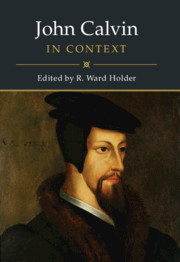Book contents
- John Calvin in Context
- John Calvin in Context
- Copyright page
- Dedication
- Contents
- Contributors
- Acknowledgments
- Abbreviations
- Introduction
- Part I France and Its Influence
- Part II Switzerland, Southern Germany, and Geneva
- Part III Empire and Society
- Part IV The Religious Question
- Part V Calvin’s Influences
- Part VI Calvin’s Reception
- 42 International Calvinism
- 43 Calvin Legends
- 44 Calvin and Calvinism in Early Modern England, Scotland, and Ireland
- 45 Calvinism in the Early Modern Netherlands and the Dutch Atlantic World
- 46 Calvin in Asia
- 47 Calvin’s Theological Legacy from the Seventeenth through the Nineteenth Centuries
- 48 The Reception of John Calvin in the Twentieth and Twenty-First Centuries
- Conclusion
- Bibliography
- Index
- References
46 - Calvin in Asia
from Part VI - Calvin’s Reception
Published online by Cambridge University Press: 14 November 2019
- John Calvin in Context
- John Calvin in Context
- Copyright page
- Dedication
- Contents
- Contributors
- Acknowledgments
- Abbreviations
- Introduction
- Part I France and Its Influence
- Part II Switzerland, Southern Germany, and Geneva
- Part III Empire and Society
- Part IV The Religious Question
- Part V Calvin’s Influences
- Part VI Calvin’s Reception
- 42 International Calvinism
- 43 Calvin Legends
- 44 Calvin and Calvinism in Early Modern England, Scotland, and Ireland
- 45 Calvinism in the Early Modern Netherlands and the Dutch Atlantic World
- 46 Calvin in Asia
- 47 Calvin’s Theological Legacy from the Seventeenth through the Nineteenth Centuries
- 48 The Reception of John Calvin in the Twentieth and Twenty-First Centuries
- Conclusion
- Bibliography
- Index
- References
Summary
Calvin’s theology and ecclesiastical practices reached the shores of Asia by way of the Dutch and their efforts to monopolize spice trading in the South and Southeast Asia regions starting from the late sixteenth through the seventeenth centuries. Following the Union of Utrecht of January 1579,1 the two northern provinces of the Netherlands, Holland and Zeeland, acknowledged only one branch of Protestantism, namely Calvinism, as the accepted form of religion. While the other five provinces declared that people were free to choose their own form of religion, in practice, the Reformed church became the privileged church in the Dutch Republic. When the Dutch under the leadership of Cornelis de Houtman arrived in Banten (or Bantam) in the northwest corner of Java in 1596 to begin their exploration of monopoly of spice trading, they paved the way for Calvinism to be introduced to the majority of the Southeast Asian regions.
- Type
- Chapter
- Information
- John Calvin in Context , pp. 409 - 417Publisher: Cambridge University PressPrint publication year: 2019

